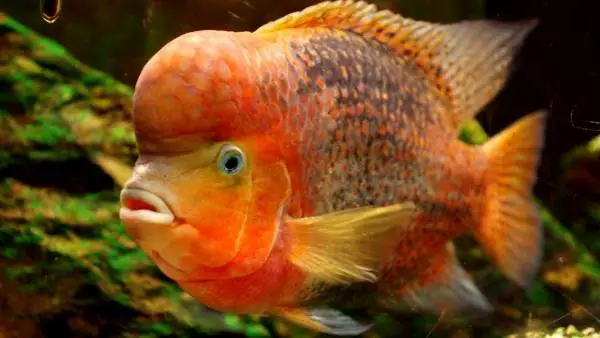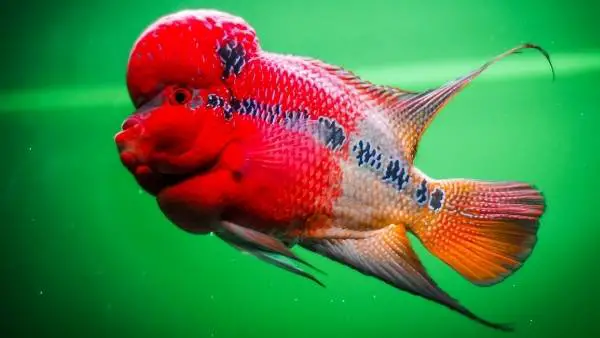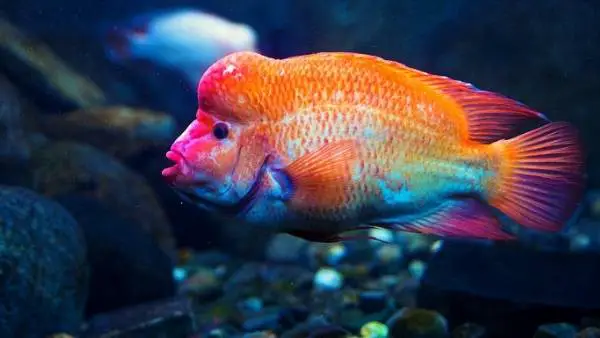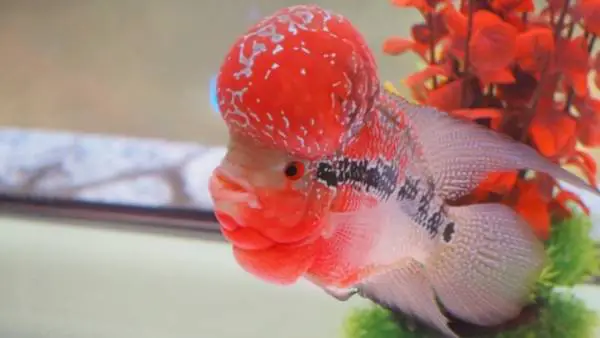It is simply a given that any fish with the word "devil" in their name is going to be somewhat unique, to say the least. For the Red Devil Cichlid, this is certainly the case, with this awesome fish carrying a plethora of funky traits and characteristics that make it a must-have for any experienced hobbyist. Oh, and not to mention, they are one of the most colorful freshwater fish in the fishkeeping world.
This member of the Cichlid fish species is a large, beautiful, charismatic, and perhaps fairly aggressive fish, but also holds a brilliant relationship with its owner, with many having compared it to that of a dog with its owner. The Red Devil Cichlid originates from Central America, native to lakes Nicaragua and Managua in Nicaragua. Cichlids in general, either hail from South and Central America or Africa.

Red Devil Cichlid Requirements and Information
- Minimum tank size: 55 Gallons (208 Liters) for a single red devil fish.
- How many: they should live singularly, pairs are accepted if the tank is large enough.
- Maximum length: 15 inches (38 cm).
- Saltwater or Fresh: The Red Devil Cichlid is purely a freshwater fish, meaning that it is not a tropical fish and should not be confused with other bright and colorful saltwater fish.
- Official name: the scientific name for the Red Devil is the Cichlasoma Labiatum.
- Ideal water temperature: 75 to 79 degrees F (24 to 26 °C).
- pH level: 6.5 to 7.5.
- Lifespan: between 10 to 12 years.
- Breeding preferences: they are open spawners.
- Typical tank behavior: they tend to swim around the entire tank, they don't just stick to one place.
Natural Habitat
So, as we brushed on previously, the Red Devil fish (Amphilophus Labiatus) inhabits the Nicaragua, Managua, and Xiloa lakes in North America, making it a strictly freshwater fish.
They much prefer the lakes to open waters, where they inhabit rocky areas with many safe hiding spots and places to rest. The waters in general are dark and murky, and they will eat almost anything running along the bottom of the lake, this does include small fish, larvae, and of course, snails!
Biology Behind the Fish
Despite being named the "Red Devil", the colors of this Cichlid do vary. When living in the wild, they will take on a more brown/gray appearance, significantly darker than when in an aquarium, this is due to them needing to blend into their environment.
In captivity they come in an abundance of bright and beautiful colors, ranging from pale yellow, bright red, neon orange, and even sometimes you can find a white Red Devil Cichlid!

In terms of size, the males will usually be larger than the females, not significantly, but they are usually bigger. Both have the same body shape, stocky and thick.
Both their dorsal and anal fins sweep backward and end in a point, with some of these fish having black tips on their tails and fins. They also have a plethora of sharp teeth and powerful jaws, which is what makes them such prolific predators. The downside to this is that they can be pretty aggressive and destructive towards plants and other fish in your aquarium.
Comparison with other Cichlids
So, the Midas Cichlid (Amphilophus Citrinellus) is commonly confused with the Red Devil Cichlids. However, despite the similarities, there are some subtle differences between the two that can be used to differentiate.
Firstly, the Red Devil has larger lips, compared to the Midas Cichlid's notably thinner ones. The majority of Red Cichlids have orange lips, but some others do have black lips. Additionally, there are other cichlids, such as the Bolivian Ram, that are significantly smaller in size than the red devil.
Sexing
Possibly the most notable difference between male and female red devils is the nuchal hump that is clearly present on the male red devil, forming somewhat of a hump-shaped horn on their foreheads.
In the wild this hump usually only appears during breeding/spawning times, however, in captivity, the hump can be present at all times. Another difference between the two sexes is the male's pointed genital papilla, in contrast to the female's blunt papilla.
Red Devil Cichlid Size and Growth Rate
This is not a small fish by any means (they are when they are young) and will require a rather large, established aquarium. At its full growth size it is 15 inches, which is roughly 38 cm in length, this is certainly a large cichlids species.
It is good to be aware of their breeding habits too, even a 6 inch (15 cm) Cichlid can mate, which is unusual for these kinds of large fish, and it can take up to 3 years for them to reach their full size, with a growth rate of a couple of inches per year until fully grown.
Lifespan
Obviously dependent on several factors, the Red Devil Cichlid can be a member of your freshwater community for a substantial amount of time. With good care and a healthy, balanced diet and lifestyle you are looking anywhere between 10 to 12 years.
The biggest determining factors are water quality and diet, if you get these right, these great fish will easily live for over a decade.
Behavior - Are They Aggressive?
Unfortunately, they are called the "red devil" for a reason. The Amphilophus Labiatus is somewhat of an aggressive fish, gathering a pretty bad reputation when it comes to other tank mates and smaller fish especially.
However, when it comes to you, and fellow aquarists, they react extremely well, and show a lot of attention and affection your way. Many describe the relationship between this cichlid species as that with a pet dog. Following their owners around, being playful, and displaying all-around attentiveness, they are highly interactive fish.

As mentioned, they can be pretty aggressive fish, and unfortunately, this aggression is unleashed on other fish in the tank, even adult fish and other Cichlid species. And while you can still keep them with other fish with similar temperments, they are recommended to be kept alone once they become adults.
What many Red Devil owners tend to do is keep them within giant communities in big aquariums, giving these territorial fish the space they desire. Not only are they aggressive towards other fish, however, they are also pretty bad when it comes to aquatic plants and other aquarium decoration, ripping up plants from the ground and digging around the aquarium gravel bed. Unprotected equipment is also not safe, and the same goes with driftwood and rocks, so you'll want to glue these things down if you want them to stay in one place!
Aquarium Setup
The tank must be no less than 55 gallons (250 liters) for a single fish. This is because of their habits, they enjoy digging around, finding homes in big spaces.
Make sure that there is a lot of open water too, for them to swim around in regularly. A good option to go for if you are planning just one of these Red Devils is the Tetra 55 Gallon Aquarium kit, which provides not only a tank that is perfect in size and shape, but additionally gives you the required setup materials.
Introducing a dark-colored sandy substrate is certainly a good idea, and will be well received by your red devil. other tank inclusions should be rocks and driftwood, which both represent natural hiding spaces they would use in their natural habitat. There isn't much point in adding live plants as they will typically tear them up or uproot them, which causes a mess that you will inevitably have to clean up.
Water Conditions, Water Quality and Equipment
Water quality is a huge factor in your fish living a healthy and happy life. You must replace the water on a weekly basis, by replacing around 25% to 30% of the water each time.
It is also crucial that you keep the temperature between 75 to 79°F (24 to 26°C), with a pH level range of 6.5 to 7.5. Your water hardness should be between 6 to 25 dGH.
The Cichlid species as a whole can handle a whole range of water conditions, however, it is important to keep the water well-oxygenated using an air stone, or something similar.
Having a current is key too, make sure the filtration system has at least a moderate current. You can protect these by mounting them externally so that the Red Devils cannot reach them.
Moderate lighting will do them just fine as they aren't particularly fussy when it comes to lighting requirements. And finally, when you are cleaning your tank, using a siphon to clean away waste material is the best option.
Red Devil Cichlid Tank Mates
Perhaps one of the toughest things to get right as a hobbyist, even if you do purchase fish that "get along" on paper, you can be unfortunate enough to simply land yourself with a group of fish that simply just do not get along.
With the Red Devil Cichlid, it is strongly recommended to keep them singularly. When they are young and growing they tend to be absolutely fine with other fish that share a similar temperament, however, they are still recommended to be kept alone from a young age.
The risk is, when they get older, bigger, and more aggressive they could easily turn on their tank mates and become incredibly hostile. Keeping the peace in any community is hard work, but it will become a nightmare if you do not have a big enough tank, follow the recommendations here and you should be fine.
Here are some fish that "on paper" can co-exist with younger Red Devils:
- Convict cichlids
- Jack Dempsey (not the boxer!)
- Firemouth cichlids
- Firemouth cichlid
Food Consumption, General Diet, and How Often Should they be Fed
Red Devil Cichlids are omnivores and will eat virtually anything. They do best with a well-balanced diet, which includes live, frozen, and fresh foods with additional flakes or cichlid pellets.
They will also accept earthworms, bloodworms, crickets, and krill, however, it is recommended to keep them on a balanced diet with plant-based foods too. Such as Spirulina flakes, lettuce, broccoli, or shelled peas. Your Cichlid will require being fed several times a day - but make sure you do not overfeed it!
Breeding
When it comes to breeding Red Devils it isn't too hard, the fish will naturally form breeding pairs and are open spawners, which means they will lay their eggs in the open water. The female cichlid will lay anything between 600 to 700 eggs on a flat rock or an inclined surface, they are yellow/orange in color, and will hatch after three or four days. Caring for their fry is not hard either, the male and female will protect them, most of the time the male will even dig a hole to move the fry into it for protection.
It tends to take around a week (7 days) for the fry to start swimming around, they will feed on artemia nauplii. Another awesome thing about the Red Devil is that they are not prone to any diseases and will likely be healthy for their whole lives if you take care of them properly. They can, however, contract common tank illnesses if the tank is unclean and the water conditions are bad.
Ich is a fairly common illness these fish contract, it can be simply rectified by correcting the water conditions and using specific fish medication. Another, slightly more worrying disease is called "hole in the head disease" and is also contracted by bad water quality and poor diet, you will notice this disease when a hole appears on your fish's face or head - make sure to constantly clean your water filter!
Thoroughly cleaning any new items that you introduce to your tank is so important, and also constantly replacing 35% of the water in your tank on a weekly basis is key.
How many Red Devil Cichlids per Gallon? Tank Size
It is recommended to have a single Red Devil in a large aquarium, especially if it is fully grown in a 55-gallon tank, which is 250 liters. If you are looking at building a community around the red devil then you will need 200 gallons or more - a considerable size tank for most people.

The reason for the larger tank size is that it gives these playful fish more space to explore and settle, they are pretty big fish after all! The larger the tank, the happier the fish tend to be, and this certainly has a reflection on their behavior too, and their temperament around other fish. With multi-species tanks, more space allows them to establish homes and territories.
Conclusion and Final Recommendations
Despite the obvious drawbacks, i.e. their aggressive nature and potential tank bully status, the Red Devil Cichlid is an incredible fish, not only beautiful to look at with its bright colors and unique body shape but they do have a lovely relationship with owners.
It is obviously key to find the right tank mates for them by following our recommendations and advice. Their nature does require consistent routine tank monitoring if they are to be kept living with other fish, you wouldn't want any of your community going missing after all.
The fish themselves are pretty commonly found and can be bought in stores, or online for approximately $18 per Cichlid. Do not purchase one of these if you do not have the time, tank size, or right community for their specific requirements. Additionally, having dual filters and air stones will certainly help in keeping their environment nice and healthy in order for them to live happy and healthy lives.

